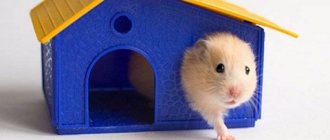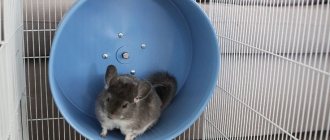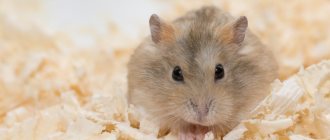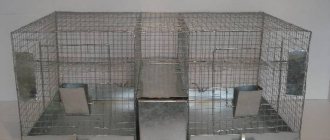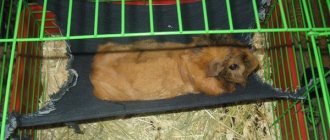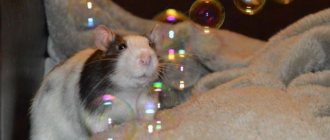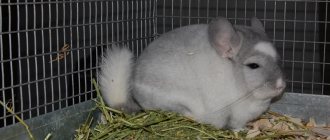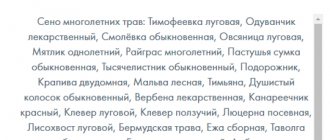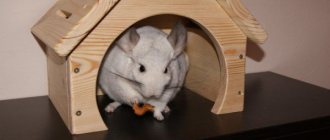Chinchillas are naturally very active animals. Pet owners often place various toys in their cage. It is worth noting that chinchillas are shy animals, so if you want to play with them, you will have to first tame the animals into your hands. You need to give some time for the chinchilla to get used to its new environment.
You should not remove the chinchilla from the house yourself. Open the cage and allow the animal to come out when it is ready. A house for rodents is a place where they feel safe.
The chinchilla will gradually get used to you and will play with you. Before releasing the animal into the apartment, it is necessary to remove in advance objects that can be traumatic for the pet: remove valuable and sharp objects.
You should not practice walking your chinchilla on the street. With a sudden change in environment, the animal may experience severe stress due to new smells and sounds, which will negatively affect the chinchilla’s overall well-being. There is also a high risk of contracting parasites or disease.
Types of toys for chinchillas
Toys for furry rodents are made from different materials, but they all have one common requirement - safety. Therefore, you should not buy and use toys from:
- Plastics,
- Rubbers,
- Plexiglas,
- Cardboard, foam or paper,
- Any material with a high content of gels, paints or varnishes,
- Any material containing cement or lime.
Most often, toys for animals are made from ceramics, wood, stone, metal and plant fibers.
Wooden toys must not contain any traces of paint and be made from approved types of wood:
- Beech,
- And you,
- Poplars,
- Apple trees,
- Cherries,
- Birches.
Wooden toys can be either static - attached to the floor or walls, or free-lying. All kinds of swings and ladders, houses, shelves, labyrinths and ladders are most often made from wood.
When choosing a ceramic toy, you should carefully inspect it for the absence of sharp corners or protrusions. You can use flower pots, drainage pipes of suitable diameter and other pottery items.
Stone toys are designed to grind down constantly growing teeth, which means they should not contain dangerous inclusions. Most often, stone toys are stones for grinding teeth. Sometimes they are shaped like a castle, a fruit or a vegetable.
All kinds of ropes, hammocks and ladders, ropes, bedding, baskets and bowls are made from plant fibers. The main condition is that the fabric must not be bleached or dyed.
Metal toys are represented by various running wheels.
Implementation of a two-story project
A multi-level project is easy to implement from two or three sections, made according to the principle of a one-story house. Sections can be made in different sizes. They are fastened together with dowels or self-tapping screws. The ladders are made of wood.
How to make an arched mold
To make an arch-shaped house for a chinchilla, you will need:
- plywood sheet 20 mm thick;
- planks 30 mm wide and 20 mm thick;
- ruler and compass;
- jigsaw;
- sander;
- electric drill;
- furniture dowels.
How it's done:
- On a plywood sheet, using a compass, you need to draw a circle with a radius of 15-17 cm.
- A circle is cut out with a jigsaw and cut into two equal parts, which will serve as the front and back walls.
- Mark and cut out an entrance for the animal and a window on the front wall.
- All edges of the parts are carefully polished.
- Cut and sand slats 25 cm long.
- Using an electric drill, drill holes in the slats and along the circumference of the walls at a distance of 30 mm.
- Fasten the prepared parts.
You cannot varnish or paint a wooden house. A few grams of the chemical is enough for a chinchilla to become poisoned, even to death.
Why does a chinchilla need toys?
Since chinchillas spend almost their entire life in a cage, the owner’s task is to diversify their pet’s leisure time as much as possible. Various toys come to his rescue that will make life in a confined space more fun. In addition, active animals will have no time for bad habits, such as plucking their fur.
What toys are needed
There are three types of toys that will surely be of interest to restless chinchillas:
- Moving. They are designed for active play both inside and outside the cage. These include various rotating wheels, balls, balls and bouncers.
- Static. This includes stairs, tunnels, hammocks and swings. With their help, you can decorate the cage, as well as wisely use the space inside it.
- Handy items. They come to the rescue when you have not yet decided on the taste of your animal, or when all the available toys in the cage are boring to him. In every apartment there will always be a couple of objects that the chinchilla will be interested in playing with.
Interesting ideas for arranging a cage
Many owners prefer to equip a chinchilla’s home to order or independently, based on the pet’s preferences.
These furry animals are good at jumping with the help of their developed hind legs. Therefore, shelves at different levels are attached to the walls of their home for jumping.
The maximum height of the shelf is 80 cm, so that if the animal accidentally falls from it, it will not be injured.
Tunnels are made of plastic pipes and wood. It is advisable to make the edge of metal, otherwise it will quickly be chewed off. With some effort, you can weave a tunnel from willow twigs.
An inclined stick with circles of steps made of wood attached to it, or a small board with low slats attached are suitable as a ladder.
Ideas for arranging a cage
Chinchillas love chewable toys. They are easily made from pieces of sticks and wooden circles, previously washed and dried. Holes are made in the pieces of wood, then they are strung in random order onto galvanized wire, a chain and hung in an accessible place.
To add interest to the hanging toy, you can attach a bell.
Watching chinchillas play and exercise is great fun. Especially knowing that joy is brought through your own hard work. Diversifying the life of pets and making it more fun is the task of a responsible owner.
How to play with a chinchilla correctly
Despite their activity, chinchillas are rather shy animals. It takes them a long time to get used to the new environment and owner. It will take you time to train your pet.
This needs to be done gradually. To play with your pet, you first need to prepare the room: remove excess furniture (a rodent can hide and get stuck under it), hide objects that should remain intact (chinchillas tend to gnaw and bite everything in their path).
Why doesn't the animal drink from the drinking bowl?
Chinchillas, despite their natural mobility, do not have a special love for water. They drink rarely and little, often the decrease in water during the day is unnoticeable.
However, it is always necessary to have access to water in the cage/enclosure. To completely refuse to drink, an animal needs a good reason. The reason may be:
- Water contamination, staleness, foreign unpleasant taste.
- Unaccustomed. Chinchillas sometimes get used to lapping from a bowl or using one type of sippy cup, and when the drinking structure changes, the rodent simply does not understand what it is and how to use it.
To correct the situation, you can change the water in the bottle or the drinking bowl itself. Well, or you can try to accustom the chinchilla to a new design.
Everything has its time
Before offering toys to your chinchilla, create a comfortable environment for the animal. The animal must get used to the environment and its owners. If you are going to let your pet out of the cage, you need to clean the room: there should be nothing unnecessary on the floor, much less dangerous for the rodent.
To begin with, you should stay away from the chinchilla - give him the opportunity to explore the new space on his own. Under no circumstances should you frighten the animal with loud sounds or sudden movements; you should not turn the lights on or off. It is also very important for the animal that the path home (to the cage) always remains open.
When the rodent gets used to the environment and gets a little “bored”, it will begin to bite and pinch everything in its path. At this time, you can offer him new toys. Just be prepared for the fact that the animal will remain indifferent to the “gift” - it will decide for itself what it likes to play and what it doesn’t.
What toys are suitable for chinchillas:
- moving;
- static (interior);
- from scrap materials.
As for the cage, it should also have toys - this is a prerequisite. The fact is that an active animal needs to constantly expend energy. And if he doesn’t find something to do, he will start chewing his fur out of boredom. Alas, these small animals are also susceptible to bad habits (the problem is partly solved by chinchilla training).
Soft, cute, gnawing: who is it?
Chinchillas are cute rodent pets famous for their warm, dense fur and adorable faces. They are bought by those who want to make their home more comfortable, because these animals are so cute! But we must not forget that this furry creature also needs comfort and coziness. Therefore, you can make a cute house for a chinchilla in which the animal will feel safe.
Chinchillas are crepuscular animals, so a cage house will be very useful so that your pet can hide there during the daytime and take a good nap. A home for a chinchilla is as necessary as a bed for a person, so don’t skimp on such important little things.
Static toys
These entertainments can also be classified as interior entertainment, since they look less like toys and more like pieces of furniture in your pet’s home. Nevertheless, they allow the animal to maintain activity at the proper level.
Shelves
Shelves are a universal exercise machine for rodents that have weak front legs and strong hind legs. They allow the animal to jump, quickly changing its location. The optimal height for the shelf is 80 centimeters. Shelf made of natural wood - Linden! (not pine!! which has a lot of harmful resin emissions). You don't have to worry about your pet, Linden is one of the most useful tree species! For example, the well-known linden tea has long been used in the treatment of many ailments. The most natural tooth grinder is wood! And a tasty and healthy shelf will last for a long time.
STICKS AND STAIRS
An ordinary wooden stick placed in a cage causes no less delight in the tailed ones; it can be rolled, chewed, and climbed up (if you place it between the floor and the shelf). The ladder is a modernized version of the stick that performs similar functions.
Tunnels
The tunnel is an interesting means of transportation that will add variety to your cage; some chinchillas even like to rest there or hide in pipes of different diameters, making their way through them and running after each other. The tunnels can be of any size, but at least 30-40 centimeters in diameter, so that the pet does not get stuck inside.
Tunnels are mainly made of plastic and wood, and the second option must have an iron edging so that the chinchilla cannot chew the edges. Some manufacturers offer a whole network of tunnel passages made of plastic, which can be disassembled and assembled, giving the shape as desired.
Decaffeinated coffee - harm and benefits of the drink - what properties and contraindications it has
Tunnel system
Translucent plastic is recommended as a material: the animal will feel safe there. You can always find a rodent who has simply fallen asleep inside the exercise machine, without fear that he is stuck there. It is best to choose tunnels from transparent materials so that the chinchilla can always be found.
Hammocks
By installing this device inside the cage, you will see how much your chinchilla will love it. In this mini-bed you can not only relax, but also swing. It is worth noting that the tastes and characters of these animals are just as different as ours. As for hammocks, all animals like them, but some like closed models, others prefer to relax in open hammocks, while others cannot be kicked out of hammocks - pipes Thus, you have the opportunity to save money and show your love and care in your creativity by trying to sew all three hammock models yourself, and your little animal will choose and evaluate the most successful one.
You can, of course, hang a hammock on thin satin ribbons, if you have a stock of such ribbon, about the size of a wagon, it is best to find a metal chain that the chinchilla will not chew through.
We figured out the fastening, but to sew a hammock for your chinchilla you will need:
- thick denim - a cut of 100 by 30 centimeters, or just a piece of denim pants;
- thick threads;
- needle with a large eye;
- scissors.
With the trouser leg, everything is simple, you just need to fold it on both sides, if you have a piece of denim for work, then you need to first sew it into a tube and then bend it. At both ends you need to make loops of fabric, and attach a pair of small carabiners to them, to which you attach a metal chain. That’s basically it, the hammock for your animal is ready.
Most commonly used materials:
- tree;
- thick fabric;
- bendable but durable plastic.
From scrap materials
It is not necessary to attract a pet with new products from the store - chinchillas are happy to pay attention to toys made from scrap materials. Sometimes you don't even need to do anything - just give them a rustling object that they can chew or roll. Use options such as:
- walnut - animals will roll it throughout the cage for a long time, enjoying the roar;
- a wooden thread spool is not only an interesting toy, but also a good teeth sharpener;
- a small piece of thick rope tied into a knot at one or both ends. Please remember that this product should be given with caution. Make sure that the long-eared animals do not try to swallow threads, which can damage the stomach.
Buy or make it yourself?
Many people are faced with a dilemma: whether to buy a house for a chinchilla or make one with their own hands. After all, those that are already sold in stores may not meet your preferences and are not entirely suitable for chinchillas.
Also, finished products may not be made to the highest quality. And the materials that were used to create it may not be safe for your pet, so most people decide to make it themselves.
REFERENCE! This will be especially easy for those who are involved in carpentry or at least have an idea about it.
In most cases, home-made housing is no different from store-bought ones, and sometimes it even turns out much better. And you don’t have to worry about your pet’s safety, since you will know exactly what it’s made of.
Requirements for the toys used
There are certain standards that toy devices for chinchillas must meet. First of all, they relate to the material of the products - the list of prohibited items includes:
- rubber;
- low quality plastic;
- cement, lime;
- paper and cardboard products;
- glass.
Some types of wood should also not be used. For example, oak, cherry, and conifers contain resin, which will certainly end up in the stomachs of these lovers of chewing everything. Resins can cause digestive upset and poisoning. There are other contraindications:
- the presence of small objects that the animal can bite off and swallow;
Toy with small objects - factory dyeing on toys - even if the paints are made from safe substances, the animal’s skin easily takes on their color. Give preference to items in neutral colors or without colors at all;
Bright dyes - sharp corners, jagged edges that can easily cause injury.
Rough surface of products
It is recommended to have a variety of different toys in stock that will diversify the life of a rodent. But you need to put them in the cage gradually so that your pet doesn’t quickly get bored with them. Too many play equipment clutters up the living space needed for free movement around the cage.
Prices for toys and decor for rodents
Wheels
A wheel that can rotate is a good exercise machine for a chinchilla, which also serves as entertainment for it. It is produced in several versions:
- made of plastic (not very durable, but quite safe, up to 32 cm);
- made of wood (high-quality environmentally friendly material, but such wheels for chinchillas are made only to order);
- made of metal (durable, but unsafe: the animal can be injured while running or get stuck in the mesh covering the wheel).
Instead of a fine mesh, it is better to cover a metal wheel for a chinchilla with thick cotton (old jeans).
Prohibited Toy Material
There are certain standards that toy devices for chinchillas must meet. First of all, they relate to the material of the products - the list of prohibited items includes:
- rubber;
- low quality plastic;
- cement, lime;
- paper and cardboard products;
- glass.
Some types of wood should also not be used. For example, oak, cherry, and conifers contain resin, which will certainly end up in the stomachs of these lovers of chewing everything. Resins can cause digestive upset and poisoning. There are other contraindications.
With small objects
The danger is that the pet may swallow small devices.
Factory painting
The animal's skin easily takes on their color. Choose items without bright colors.
Sharp corners, jagged edges
Your chinchilla can be injured by such products, as well as by their roughness.
In addition, some types of wood are harmful to chinchillas. For example, oak, cherry, some conifers.
It is recommended to have a variety of different toys in stock that will diversify the life of a rodent. But you need to put them in the cage gradually so that your pet doesn’t quickly get bored with them. Too many play equipment clutters up the living space needed for free movement around the cage.
Making a simple wooden structure
Step-by-step steps for making a wooden structure measuring 35x25x25 cm without a bottom:
- Apply markings to the workpieces.
- Cut out the walls and roof with a hacksaw.
- Mark the entrance on the front wall and windows on the side walls.
- Cut out the entrance hole and windows along the outlined contours.
- Sand the edges of the resulting parts.
- Drill holes in the walls and roof for furniture dowels.
- Fasten the walls and roof.
- Disinfect the product with a cloth moistened with water and alcohol.
- After drying, place the product in the cage.
To extend the durability of the product, the edges of the house parts can be covered with metal plates. Branch food and hay should always be present in the cage.
Accessories
Transporting pets is a necessity often associated with visits to the veterinarian or relocation. To safely deliver your pet, a wide variety of carriers are available for sale, the cost of which can vary significantly.
Carrying
An important accessory, especially if you like to travel and plan to take your pet with you. For transporting your baby, carriers made of opaque plastic are best suited. They are lightweight, easy to clean, resistant to the absorption of foreign odors, and will protect the rodent from drafts. The size should not be less than 15x20x20 cm.
Leashes and harnesses
A harness is the best option for safe and convenient walking of small rodents. The harness is firmly fixed on the animal's body; the length adjusters allow you to adjust the length of the harness to the desired size. A leash is also firmly attached to it in order to become familiar with the outside world.
Benefits of soft carriers
A carrying bag allows you to protect your pet from outside influences.
We invite you to read: Herpes in cats: symptoms of the virus, treatment of infection, myth about the ability to be transmitted to humans
The animal will feel protected and experience less stress.
The fabric container is lightweight.
It is easy to store and does not burden the owner when transporting the pet.
Fabric carriers are elegant. Some varieties are no different from the usual bags.
For a fashionista traveling with a pet, a container can complement her look.
The carriers are made of material that easily allows air to pass through.
The pet will not lack oxygen or suffer from heat.
A properly selected container will not only make your trip easier, but will also guarantee comfort throughout the journey.
Unlike hard plastic baskets or metal cages, the animal feels more protected in a soft, cozy house. There is always an opportunity to hide from prying eyes, to hide from danger. This type of carrier takes up less space than a rectangular plastic box. In addition, through the flexible walls you can stroke and calm a pet frightened by an unfamiliar place, which may react inappropriately to a hand inserted inside, scratching the owner.
Self-tailoring provides ample opportunities for flights of fancy when decorating. All kinds of fabrics of original colors, beads, ribbons, buttons, braid, and other decorations are suitable for this. The bag can be made in the form of a familiar ladies' accessory. If the owner sewed such a carrier herself, she has the opportunity not to part with her pet even in those places where pets are usually closed.
Since making a mobile house for a pet is not particularly difficult for those who know how to operate a sewing machine, you can create a whole collection of designer attributes for different occasions: a light bag for the warm season, an insulated one for the winter, an elegant one for a trip to the guests, extravagant - for visiting tailed animals exhibitions.
In addition, an original portable bag for a cat, handmade and lovingly sewn to its individual dimensions, will be an excellent gift for a lover of these wayward pets.
Let's take a step-by-step look at sewing a carrier bag for a small cat or kittens.
Such a bag can be sewn, for example, from an old raincoat. In this example, the bottom and top are stitched. It is recommended to use fabric that is not very thick so that it can be sewn on a sewing machine. The bag consists of the following parts:
- the upper part is a rectangular piece measuring 32*55 cm,
- the bottom of the bag is a rectangular piece measuring 32*20.5 cm,
- two sidewalls,
- pens.
Dimensions are shown without seam allowances.
Beginning of work
Let's make patterns for the main parts of the bag on paper and cut out the parts from fabric.
When the main work of making the bag is completed, you can begin decorating.
Rhinestones, beads, threads, seed beads, applique, and fur are used for decoration. Decoration depends on the tastes of the housewife, the decorations at hand and imagination.
The following types of bead decoration are distinguished:
- Embroidery. This method is used primarily for decorating fabric accessories (silk, denim, cotton). In addition to beads, you can use rhinestones, coins, and ribbons.
- Pasting. It is suitable for leather, plastic, oilcloth and suede bags. Only use clear quick-fix adhesive. You will also need tweezers and a clean cloth to remove excess composition. After registration, the decor should completely stick together, this will take about two days.
The bag can be decorated with bead appliqué. The future decoration is woven separately and then simply glued or sewn to the bag. You can use this method if you plan to create a small beautiful accent on the bag in the form of a flower or a funny character.
Fur care
But what is really needed is a good brush to care for the animal’s thick fur. They get used to using a comb gradually. Usually chinchillas like this procedure and do not express dissatisfaction. Regular brushing will help avoid many problems with skin and fur: dermatitis, fungal diseases, infection with skin parasites. Also, using a comb before the exhibition, you can give your pet a more neat appearance.
However, finding a special comb for a chinchilla in Russia is not so easy: the product is quite rare and expensive.
It differs from ordinary brushes for animals by thinner, sharper and more frequent teeth, which can be compared to needles from a sewing machine. This brush combs out the animal’s thick fur well. You have a better chance of purchasing a special comb if you go to a large nursery. Typically, large breeders bring specialized products from European farms or work directly with manufacturers of products specifically for chinchillas. If this is not possible or the price of the product is too high, you can choose a brush for a cat or dog with the longest and most frequent teeth.
Options for houses and main selection criteria
Some owners choose and build original homes for their beloved pets from ropes, twine, and straw. But these structures are not durable. The most popular are wooden and ceramic accessories.
There are no restrictions on the shape: it can be rectangular, oval, round or triangular. Chinchilla owners who want not only to create comfort for the rodent, but also to decorate the cage, can choose a house in the form of a medieval castle, an Indian wigwam, or a village hut.
There are several recommendations from experts that you need to consider when buying a house:
- the design must correspond to the size of the resident, the animal should not be cramped;
- It is unacceptable to have holes in which the paws can get stuck;
- It is desirable to have windows in the house for ventilation;
- the accessory should not contain small, removable, accessible elements that a rodent could swallow;
- The design without a bottom will simplify the cleaning process.
Some chinchilla owners choose models with pointed domes because of their attractiveness. But you need to take into account that these animals are curious. The pet will certainly have a desire to examine the structure. Falling from a dome roof can cause injury. Therefore, preference should be given to a structure with a flat roof.
When keeping several chinchillas in one cage, you need to install a separate house for each one. Otherwise, fights between pets are inevitable.
Adviсe
Every loving owner wants his pet to have only high-quality and safe toys and household items. Everything you need today can be purchased at a pet store. But some owners prefer home-made accessories to factory accessories. This way you can avoid low-quality materials getting into the cage, which can cause poisoning of the animal.
Important! Nothing can replace a chinchilla’s “live communication” with you; you need to communicate and play with them more!
Handy tools for furry rodent games
Owners of any pets often notice that their pets play with objects that are not at all suitable for these purposes. Chinchillas are no exception.
These animals can be truly delighted by the rolling of a walnut, the jingling of keys, the unwinding of a ball of thread, as well as climbing to the top tier of a cage along a piece of rope.
To understand what exactly interests your pet, offer him various objects and observe his reaction to them.
Important! Veterinarians do not recommend taking chinchillas outside for entertainment. In addition to the numerous diseases that these animals can become infected with in the fresh air, every outing for such a walk is a huge stress for the small animal.
